
Comparing Layer 2 launches: Onchain analysis of ETH Migration
Can comparing ETH migration give us an insight into the performance of various L2s in the past few years? Specifically, what can ETH migration in the earliest stages of these L2s tell us about their relative performance and the behavior of their communities?
By observing the ETH migration of seven layer 2 networks in two different time frames – the first 24 hours after launch and the first 2 weeks after launch – we sought to answer these questions.
Introduction
Before “On-chain Summer” hit the headlines, 2023 was already the year of layer 2s and Ethereum scalability. This year, L2 solutions have launched in waves, each promising to alleviate Ethereum’s underlying constraints with faster transactions, reduced fees, and enhanced scalability.
Every L2 launch has the same primary call to action: migrate your ETH from Ethereum. For early adopters, this ask isn’t a straightforward technical task — it is a leap of faith. The act of migrating ETH is reflective of a user’s trust in a new platform. Any Web3 user is taking a risk by interacting with a new platform, and cross-chain bridges have been particularly prone to security breaches.
An L2’s ability to attract ETH liquidity is a testament to the confidence it has garnered among the crypto audience. People who choose to migrate ETH are betting that the opportunity will outweigh the risk. This is especially acute in the earliest stages of an L2’s launch before the network has been sufficiently battle-tested.
In this piece, we sought to answer the question: can comparing ETH migration give us an insight into the performance of various L2s in the past few years? Specifically, what can ETH migration in the earliest stages of these L2s tell us about their relative performance and the behavior of their communities?
We observed the ETH migration of seven layer 2 networks in two different time frames: the first 24 hours after launch and the first 2 weeks after launch. What we uncovered are the trends, motivations, and implications of the growing L2 ecosystem — as well as predictions for future L2 launches.
Data Conclusions
Key Takeaways
Our analysis of L2 ETH migration led us to the following conclusions:
- The greatest indicator of an L2’s “success” in getting ETH migrated in its earliest stages is the presumed likelihood for a future token distribution. L2 launches that occurred at the same time with the same value proposition performed vastly differently based on whether or not they already had a token in the market.
- The pattern of ETH migration in the first 24 hours is a good indicator of behavior over the following two weeks. In other words, rarely has an L2 undergone slow adoption in its first 24 hours, then parabolic growth in the 2 weeks after.
- If there is a long-term pattern that deviates from the first 24 hours, that is the consequence of discrete, high-volume deposits from whales — not general widespread adoption.
- Conclusion #3 reveals that the risk profile of ETH migrators in the first 24 hours is similar to those who migrate in the 2 weeks following. We do not see a significant rise in the average ETH migrated over time. In other words, whales are not “holding back” and waiting to see what happens before migrating.
Layer 2 Data Approach
As mentioned, we looked at ETH liquidity migration on seven layer 2 networks. We implemented the following guidelines for our on-chain data:
- For each chain, we started looking at data on the day that the mainnet opened to public use. (Some of these chains have closed mainnets or devnets prior to launch. All had testnets prior to launch).
- For each chain, we looked only at the ETH being migrated from Ethereum through the official bridge contract. ETH migrated directly or through other bridges was not measured.
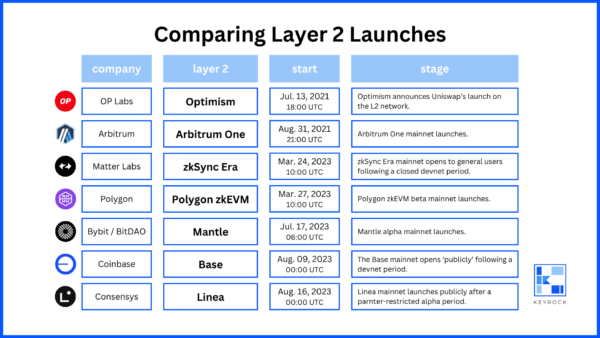
ETH Liquidity Analysis
24-hour analysis
The graph below tracks cumulative ETH migrated to each L2 on its launch day, beginning at the hour on each chain when liquidity begins to pick up.
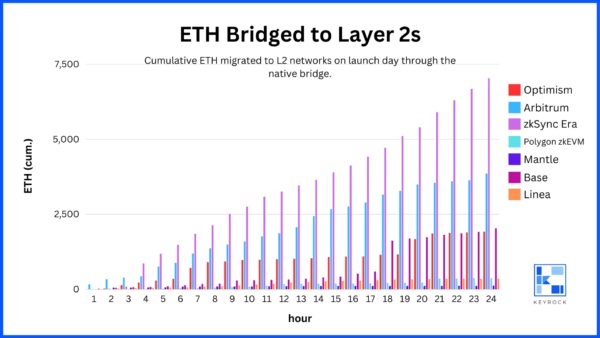
Looking at ETH liquidity migration in the first 24 hours of public launch, there is a clear outlier: zkSync Era. Built by Matter Labs, zkSync Era ended its first 24 hours with just over 7,000 ETH. The runner-up, Arbitrum, ended its first 24 hours with just over 3,800 ETH bridged.
Interestingly, these two launch outliers happened at very different times in the market. Arbitrum launched during a time period when L2s were significantly less tested, but also during a bull market with ETH at ~$3,200. zkSync Era launched not only during the current bear market (ETH ~$1,800) but also just two weeks after the SVB collapse which gave another shock to the crypto ecosystem.
It’s worth comparing the launch of zkSync Era to that of Polygon zkEVM, which launched its public mainnet just three days after zkSync Era, on March 27, 2023. Both zkSync and zkEVM promise to solve pervasive scaling issues through the implementation of zk-rollups. Although zkEVM launched during the same time as zkSync, with the same zk value proposition, and with arguably stronger brand recognition of Polygon than zkSync had with Matter Labs, it garnered much less ETH liquidity in its first 24 hours. Polygon zkEVM ended its first 24 hours with 373 ETH migrated, compared to zkSync’s 7,027.
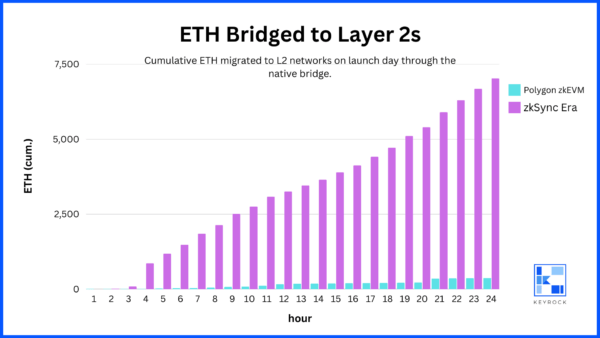
The vast difference between zkEVM and zkSync can be explained by the airdrop likelihood of each layer 2. Following the high-profile Optimism and Arbitrum token distributions, layer 2 networks became the new focus for airdrop hunters. Early adopters (i.e., ETH migrators) of L2s assumed they would receive better token distributions later on.
Polygon, of course, already had a widely distributed, high-market cap token with MATIC prior to the zkEVM launch. ZkSync Era, on the other hand, had no token. With two zk-rollup layer 2s launching within days of each other, ETH holders opted to place their bets with the protocol that had yet to launch its token. As a whole, the crypto ecosystem is still hyper-focused on airdrop opportunities, and the simple fact that Polygon was unlikely to do another MATIC airdrop resulted in a huge variation in 24 hours ETH migration between the two layer 2s.
2-week analysis
Looking at a longer time period, we can see if trends from the L2s’ first 24 hours hold up over the first 2 weeks following their launches. The following chart tracks cumulative ETH migration from the Ethereum mainnet to these L2s through the official bridge contracts during each L2’s respective first two weeks.
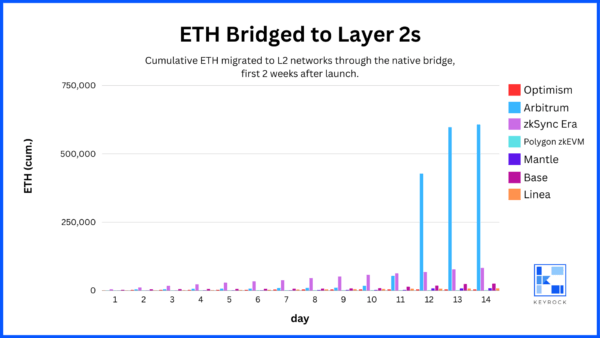
Though zkSync Era attracted 1.8x more ETH than Arbitrum in their respective first 24 hours (7,027 vs. 3,854), the 2-week time period reveals a significant deviation. Two weeks after their respective launches, Arbitrum had over 606,000 ETH bridged, whereas zkSync Era had just over 82,200.
In the first 24 hours of their respective launches, zkSync Era had attracted nearly 2x ETH than Arbitrum — even though it launched during the bear market. By the 12th day from their respective launches, however, Arbitrum had far surpassed zkSync Era. We will explore deeper into this question in the future, but our best guess is the incentive for future token distribution is what made the difference as zkSync Era launched after multiple high-profile token distributions. There’s a good chance liquidity flooded into zkSync Era in the first 24 hours as people sought to “get their foot in the door” for the future airdrop. That may have resulted in an initial spike in the initial 24 hours and then slower growth over 2 weeks.
If we remove the Arbitrum and zkSync data points (graph below), we can better compare the two-week traction of the other 5 chains.
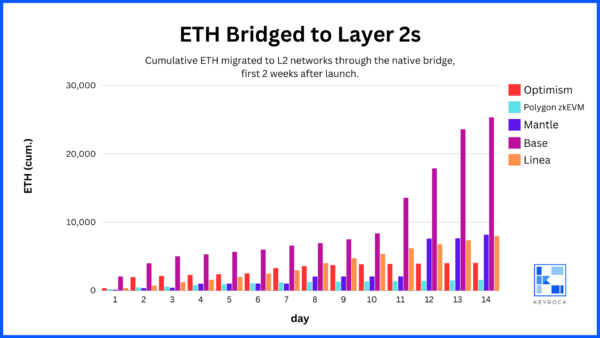
Among the remaining L2s, zkSync Era still comes out on top, followed by Base. Once again, Polygon zkEVM deserves a closer look. In its first 24 hours, Polygon zkEVM had a similar ETH liquidity migration as Linea (zkEVM = 373 ETH, Linea = 358 ETH) and had surpassed Mantle (Mantle = 123 ETH). By the 2-week mark, however, Polygon zkEVM appears to have petered out compared to Linea and had lost significant ground to Mantle, given its initial 24-hour success.
We decided to dive in deeper and try to determine why Polygon lost ground to Mantle over the 2 week period, despite having a more successful first 24 hours. The graph below compares cumulative ETH bridged to Polygon zkEVM, Linea, and Mantle over their respective first two weeks after launch.
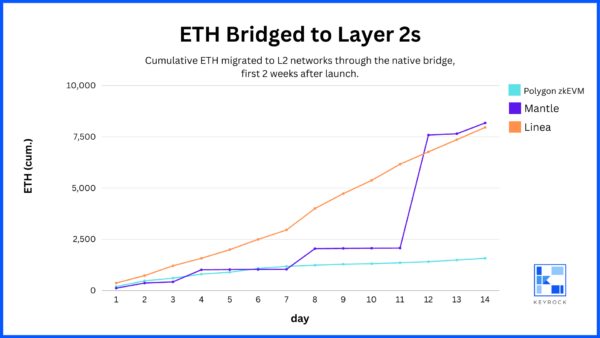
Looking even deeper into Mantle’s growth, we see that for most of its first two weeks, it was lagging behind Linea and just barely keeping pace with Polygon. That changed on day 12 after the mainnet launch, July 28. Between the hours of 17:00 and 18:00 pm UTC, 5,000 ETH was bridged from Ethereum to Mantle, increasing the cumulative ETH bridged from ~2,500 to above 7,500. Without this outlier injection of capital, it is likely Mantle would not have surpassed Linea in ETH bridged. The chart below shows the hour-by-hour breakdown of cumulative ETH bridged to Mantle on July 28, 2023.

As we can see above, Mantle’s ETH liquidity growth remained fairly consistent on July 28th, with the exception of a 500 ETH migration between 11:00 – 12:00 and then the major 5,000 ETH migration between 17:00 – 18:00. The 5,000 ETH was deposited by a single address (0x…178D), which is a Bybit deposit address.
No other L2 has such an outlier amount of ETH bridged during its first 2-week period except for Arbitrum. On September 11th, 2021 (10 days after its launch), between the hours of 16:00 and 17:00 UTC, over 180,000 ETH was bridged to Arbitrum. Over 168,000 of that ETH (+92%) was deposited by a single address (0x…54c3), which is an Alameda address. The single Alameda deposit of 180k ETH alone nearly doubled the total ETH bridged to Arbitrum, from ~180k to ~360k.

Conclusion
Looking at the 24 hours and 2-week ETH liquidity charts across all 7 L2s, we can reinforce some conclusions:
- The amount of ETH bridged within the first 24 hours is a fairly good indication of longer-term trends.
- If longer-term trends do not match up with patterns from the first 24 hours (i.e., Mantle’s growth in 2 weeks vs. 24 hours), it is due to large, outlier liquidity migrations from whales, not from cumulative migration of ETH by smaller-volume adopters.
- The most significant indicator of an L2’s success (as measured by ETH migrated) is the presumed likelihood of a future airdrop, as demonstrated by Arbitrum and zkSync Era’s dominance (especially when comparing zkSync Era to Polygon zkEVM).
ETH liquidity is a significant indicator of a community’s trust in layer 2 and anticipation of its future success. In this data piece, we’ve looked at these layer 2 networks through the lens of liquidity (ETH). In our next data piece, we’ll look at these same layer 2s through the lens of the liquidity providers and analyze their behavior 24 hours and 2 weeks after each network’s launch.
Read more: Comparing Layer 2 launches: Liquidity provider profiles
- Looking for a liquidity partner? Get in touch
- For our announcements and everyday alpha: Follow us on Twitter
- To know our business more: Follow us on Linkedin
- To see our trade shows and off-site events: Subscribe to our Youtube

